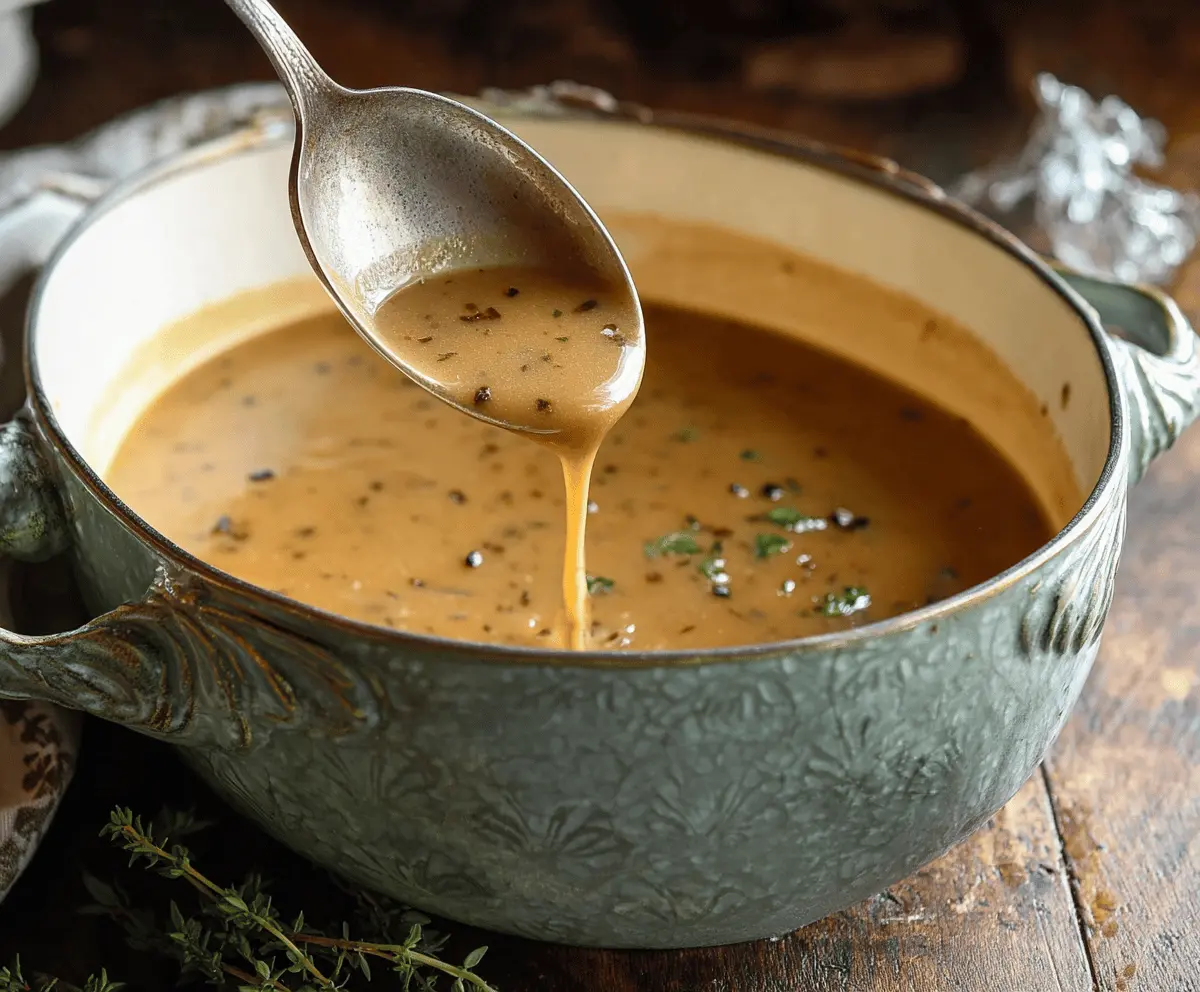Perfect Turkey Gravy is the ultimate partner for your holiday turkey, rich and smooth with just the right amount of savory flavor. Made from the pan drippings, a little butter, flour, and broth, it turns simple ingredients into a deliciously comforting sauce that brings everything on your plate together. It’s thick enough to coat your turkey and mashed potatoes without being too heavy.
I love making this gravy because it’s super easy and feels like a little reward after all the turkey roasting. My trick is to whisk constantly to avoid lumps and taste along the way so I can add just enough salt and pepper to make it sing. It’s one of those recipes that feels fancy but doesn’t take a lot of effort, which makes me happy!
One of my favorite ways to enjoy Perfect Turkey Gravy is pouring it generously over a warm slice of turkey and a scoop of fluffy mashed potatoes. It makes every bite extra cozy and comforting. Plus, it’s a hit with everyone around the table, always prompting second helpings and happy sighs.
Key Ingredients & Substitutions
Pan Drippings: These give your gravy that classic rich turkey flavor. If you don’t have enough, you can use extra broth but try to keep the pan drippings for authenticity.
Butter: It helps create the roux and adds creaminess. You can swap for olive oil if you need a dairy-free version, but the flavor will be lighter.
Flour: This thickens the gravy perfectly. For gluten-free, try cornstarch or arrowroot powder but add them mixed with cold water at the end to prevent lumps.
Broth: Turkey broth is best, but low-sodium chicken broth works well too. Avoid full-salt versions so you can control seasoning.
Fresh Herbs: Thyme and sage bring classic notes. If fresh aren’t on hand, dried herbs work fine—just use half the amount and add earlier for flavor development.
How Do I Make Sure My Turkey Gravy Is Smooth and Not Lumpy?
Making a smooth gravy is all about mixing and timing. Here’s what works for me:
- Start by melting fat and butter evenly to create a smooth base.
- Slowly whisk in flour, stirring constantly to cook it and avoid clumps.
- Add liquids gradually—don’t pour it all at once. Keep whisking as you add broth and pan juices.
- Bring the gravy to a gentle simmer; this cooks out the raw flour taste and thickens it nicely.
- If you spot lumps, whisk vigorously or strain the gravy through a fine sieve for silky texture.

Equipment You’ll Need
- Fine-mesh sieve – I use it to strain the pan drippings and make the gravy extra smooth.
- Medium saucepan – perfect for whisking and simmering the gravy to the right thickness.
- Whisk – essential for blending the roux with liquids smoothly without lumps.
Flavor Variations & Add-Ins
- Stir in a splash of white wine or sherry after adding the liquids for a deeper flavor.
- Mix in sautéed onions or garlic for extra aroma and richness.
- Add a pinch of paprika or a dash of Worcestershire sauce for smoky or umami notes.
- For a richer gravy, whisk in a spoonful of sour cream or heavy cream at the end.
Perfect Turkey Gravy
Ingredients You’ll Need:
- Pan drippings and browned bits from roasting a turkey (about 1/4 cup fat and 2 cups liquid combined)
- 4 cups turkey or chicken broth (preferably low sodium)
- 1/4 cup all-purpose flour
- 4 tablespoons unsalted butter
- 1 teaspoon fresh thyme leaves (or 1/2 teaspoon dried thyme)
- 1 teaspoon fresh sage, chopped (optional)
- Salt, to taste
- Freshly ground black pepper, to taste
How Much Time Will You Need?
This gravy takes about 10 to 15 minutes to make, including straining the pan drippings, preparing the roux, and simmering the gravy until it thickens perfectly. It’s quick and mostly hands-on, so you can prepare it right after your turkey is done roasting!
Step-by-Step Instructions:
1. Collect the Pan Drippings:
Once your turkey is roasted, carefully pour the pan drippings through a fine-mesh sieve or colander into a measuring cup. Let the fat float to the top. Skim off about 1/4 cup of fat and set it aside. Keep the remaining liquids (about 2 cups) for the gravy.
2. Make the Roux:
In a medium saucepan over medium heat, melt the reserved turkey fat. Add the butter and let it melt fully. Sprinkle in the flour, whisking constantly to form a smooth mixture. Continue cooking and whisking for 2 to 3 minutes, until it turns light golden and smells toasted but not burnt.
3. Add Liquids and Herbs:
Slowly pour in the strained pan juices and turkey or chicken broth while whisking continuously to avoid lumps. Bring the gravy to a gentle simmer. Stir in the thyme and sage, letting the flavors infuse as the gravy thickens, about 5 to 7 minutes. If the gravy gets too thick, add a bit more broth to adjust.
4. Season and Serve:
Taste your gravy and season with salt and freshly ground black pepper as needed. For an extra smooth gravy, strain it through a fine sieve before serving. Pour your perfect gravy hot over turkey, mashed potatoes, or stuffing, and enjoy!
Can I Use Frozen Turkey Drippings for Gravy?
Yes, you can freeze pan drippings after roasting. When ready to use, thaw them overnight in the fridge and skim the fat before making your gravy. This helps maintain the best flavor and texture.
What Can I Use Instead of All-Purpose Flour?
If you need a gluten-free option, cornstarch or arrowroot powder works well. Mix about 2 tablespoons with cold water to create a slurry and add it gradually to the hot liquid, stirring until the gravy thickens.
How Do I Store Leftover Gravy?
Store leftover gravy in an airtight container in the fridge for up to 3 days. Reheat gently on the stove, whisking occasionally. Add a splash of broth or water if it thickens too much while reheating.
Can I Make Turkey Gravy Without Pan Drippings?
Absolutely! Use butter or oil to make the roux and add turkey or chicken broth for flavor. You can boost it with a bit of soy sauce, Worcestershire sauce, or poultry seasoning to mimic that roasted taste.


